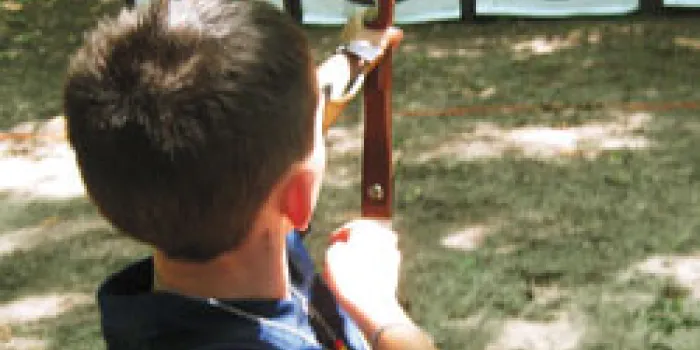Archery is a summer camp mainstay. Just ask Tim Wicks, who has been teaching the sport at Camp Bold Eagle in Holton, Michigan, for the past five years. Kids at the camp, which is run by the Hemophilia Foundation of Michigan, line up for his classes every summer.
“It’s one of the most popular classes we offer,” says Wicks, 24, who teaches archery to approximately 120 kids—and counselors—during the camp’s three-week run each July. Out in the woods, they learn how to knock, or load, an arrow on the bowstring, how to stand sideways to aim and shoot, and, eventually, how to hit the target.
“I teach beginners not to worry too much about how far the arrow will go. In the first couple of classes, we don’t even use a target,” says Wicks. He says he knew little about the sport when the camp tapped him to replace its departing archery instructor. He picked it up quickly.
“Archery is simple to learn, but hard to master,” says Wicks, before adding with a self-deprecating laugh: “Those who can’t do, teach.”
Wicks, who has severe hemophilia A, says that archery is a fun, safe sport for just about anyone with a bleeding disorder. “I’ve never had to tell a child at the camp that he or she cannot practice archery because of their bleeding disorder,” says Wicks. “Even kids who have to use a wheelchair can learn to shoot.”
It’s not just kids at camp who are eager to get into archery. According to The New York Times, the number of people practicing archery in the United States grew from 5 million to nearly 7 million between 1995 and 2005. That makes it one of the fastest-growing sports in the country.
Archery is considered a safe activity for people with bleeding disorders, according to the National Hemophilia Foundation’s (NHF’s) publication Playing It Safe: Bleeding Disorders, Sports and Exercise. However, for someone who has a target joint in the elbow or shoulder, archery practice could result in a bleed.
“Archery’s benefits outweigh its risks,” says Sherry Herman-Hilker, PT, of the University of Michigan’s Hemophilia Treatment Center in Ann Arbor. Those benefits include muscle building and toning, as well as improved coordination and balance. Upper body strength can get a real boost from drawing a bow. However, Herman-Hilker says there are a number of things to keep in mind, especially when you are a beginner.
“In archery, you are using muscles that you are probably not used to using,” Herman-Hilker says. “It is important to build up gradually, because it is easy to overwork those muscles.” Stretching beforehand is essential. By limbering up your muscles, you reduce the risk of injury, Herman-Hilker stresses.
At Camp Bold Eagle, Wicks teaches his students to shoot with a recurve bow. Recurves have tips that curve away from the archer when the bow is unstrung, and they are shorter than other standard bows, such as compound and long bows. Their design allows them to store more energy than a straight bow. The greater the energy, the faster the arrow will travel when shot. Arrows shot by Olympic recurve archers often reach speeds of 150 miles per hour.
Such bows take a good deal of strength to draw. According to the US Olympic Archery Team Fact Book, a man’s bow has an average “draw weight,” or peak weight the archer will pull while drawing the bow, of 50 pounds (a woman’s bow is 34 pounds). That kind of weight can put a lot of strain on your joints.
“It sometimes gets frustrating when you can’t pull the string back as far as you want,” says Wicks. “It takes real muscle control.” To help campers learn to shoot safely, Wicks takes a lot of time to teach proper techniques, from the correct way to stand to how best to string an arrow. Doing everything right, he says, reduces strain significantly. And that reduces the risk of bleeds.
Early in his classes, Wicks talks to campers about infusing. The camp setting provides an opportunity to get them thinking about how they can best take care of themselves. “I want them to say to themselves, ‘I want to do archery, but I don’t want to get a bleed, so here’s what I have to do,’” Wicks says.
The best time to get kids thinking about their bodies, says Herman-Hilker, is while they are doing something that excites them. “As they practice, they see precisely what I am talking about,” she says. “I can really get through to them and educate them about their muscles and stretching.”
Herman-Hilker has visited Camp Bold Eagle and watched Wicks and the kids in action. “Tim’s classes are not about getting the perfect shot, but how you can improve your skills while having fun,” she says. “Those kids absolutely love it.”
In archery, safety comes first, whether you are at camp or at an indoor shooting range in your hometown. You must use well-maintained and properly fitted equipment. Closed-toe shoes are also a must, says Herman-Hilker, as is an arm guard, or bracer, to protect against a rebounding bowstring.
Wicks spends the first part of each class reviewing safety rules. Then, it’s time to have fun. “We play all sorts of different games, just not William Tell.”

